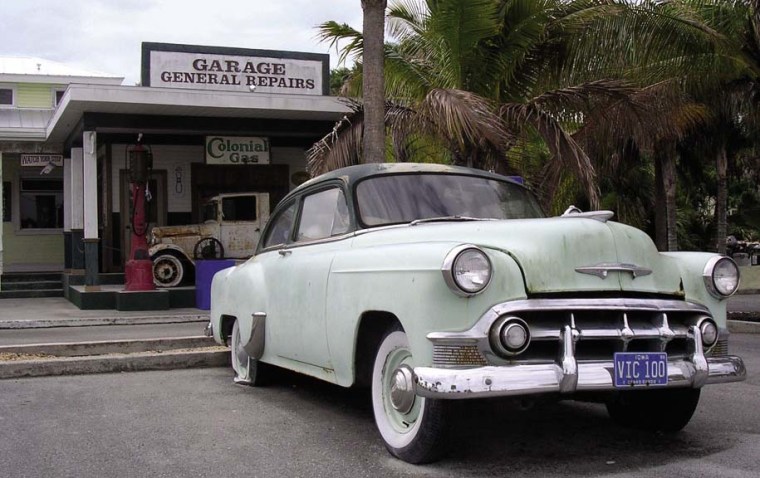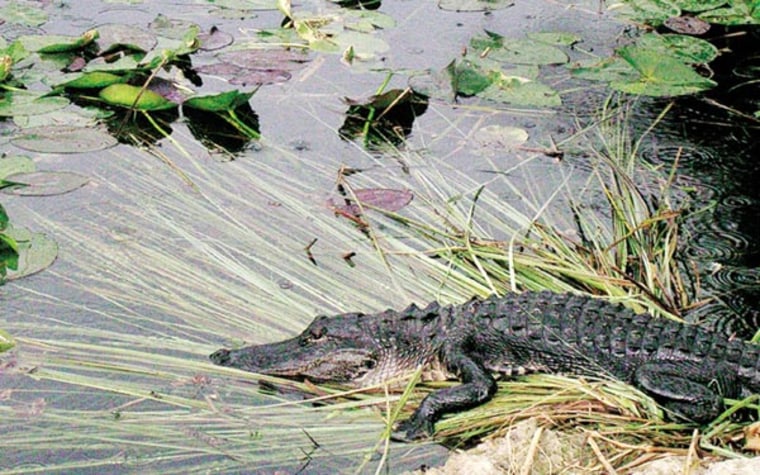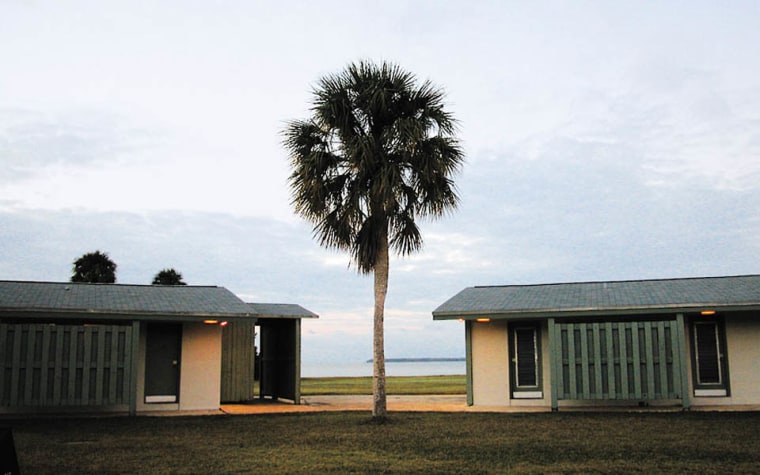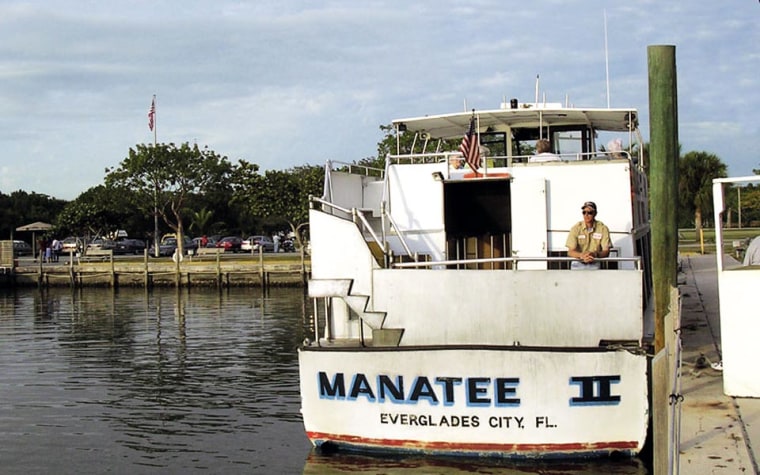Don’t eat the gator nuggets. Get that straight up front, and a road trip through the Everglades will rarely disappoint.
The Everglades is 1.5 million acres of marsh wetland, the third largest national park in the contiguous 48 states, and the only ecosystem of its kind on the planet. You can take boat rides into the Gulf of Mexico, hikes through the mangrove islands, and countless tours guided by national park rangers in funny green suits. This being the South, of course, there’s always the (mostly positive) prospect of culinary adventure.
But the main attraction is wildlife. The place is full of critters: I saw wood storks, roseate spoonbills, dolphins, turtles, snowy egrets, great blue herons, ospreys, cormorants, anhingas, a raccoon (rooting around in someone’s trash), no manatees (darn!), and about 100 members of the species Alligator mississippiensis—in the wild, in captivity, and wrestling guys named Julio.
1) Everglades City
Ah, Florida, where a suitcase is nothing more than a place to put all the clothes you had on when you left home. I flew to Fort Lauderdale on Spirit Airlines from New York City, where it was 12 degrees. My friend Josh came from Boston, where it was 4. We both quickly changed into T-shirts and headed for Everglades City, just outside the northwest end of Everglades National Park. (Because there’s only one place to stay inside the park itself—in the town of Flamingo, which we visited on our last night—any Everglades trip entails lots of popping into the park for the day and then decamping to the small towns that surround it.)
The quickest way across the Florida peninsula is Alligator Alley, or I-75. It’s about an 80-mile drive, and on both sides of the road, as far as you can see, is Big Cypress National Preserve, which adjoins Everglades National Park to the north. The tan saw-grass swamp looks like a never-ending prairie, and it reminded me of a trip I once took to Kansas. But like a good record album, the Everglades is seductive: It has a rhythm and a mood, and it isn’t long before you’re hooked.

Upon arrival in Everglades City, head for the Glades Haven Cozy Cabins. The cabins are plain and straightforward, with the look of a sleepaway camp. There’s a small marina along the river, and the place is popular with fisherfolk.
Across the street is the departure point for the Everglades National Park Boat Tours. We bought drinks at the Glades convenience store (you can bring your own food and beverages on the boat) and hopped on the last tour out to the Gulf of Mexico, known as the sunset boat. Our guide, Keith, took us by mangrove islands and through manatee zone—slow speed channels, and explained that the Everglades harbors more than 20 species of mosquitoes. (Do not make this trip in the summer.) The tour lasted about an hour and a half, and on the way back we ran into a bunch of dolphins, who spent at least 10 minutes jumping in our wake.
For dinner, we hoped to try City Seafood, a picnic-table market right on the docks; it supposedly makes a mean grouper sandwich. But like a lot of places in town, it closes at 6 p.m. That conflicted with the sunset tour, so we ended up at the overpriced Seafood Depot—home of the aforementioned gator nuggets. After dinner we shot some pool at the Oyster House, where a row of men were at the bar watching As Good as It Gets. A piano sat in one corner, a barber chair in another. I asked if one could get a haircut there. “Cut more’n your hair,” a fat guy grumbled menacingly. Where upon we left.
2) Tamiami Trail
For breakfast, the only show in town is the Oar House. The coffee was quick, and the fried grouper and grits—I’m an expert—were extraordinary.
Before leaving Everglades City, go four miles south to Chokoloskee, across a causeway packed with fishermen out for a mullet (the fish, not the hairstyle). Chokoloskee feels more residential than Everglades City. At the end of the island is the Historic Smallwood Store Ole Indian Trading Post and Museum. It used to be a trading post: furs and natural resources going out, supplies from Key West coming in. The shelves are lined with old-timey medicinal and snack-food kitsch. Mister Watson—a cat named after a famous character shot to death by everyone in town (Peter Matthiessen fictionalized the story in Killing Mister Watson)—prowled lazily. From now on, when I think about all that is weird and cool about Florida, Smallwood is what will come to mind.
Heading east from Everglades City is the Tamiami Trail—or Route 41—one of those clever names forged by squishing two others together (Tampa and Miami). The first good stop is the Ochopee Post Office. It’s the smallest, most photographed post office in the U.S., they say. We took a picture and kept moving.
Clyde Butcher’s Big Cypress Gallery is a more fulfilling detour. Butcher is a big fellow with a Santa Claus beard who has spent his life trudging through the swamp taking photographs, and the results are powerful black-and-white testaments to the beauty of the place.
The best—and only, as far as we could tell—spot to eat lunch along the Tamiami is at the diner-style Miccosukee Restaurant. The Miccosukee are one of the few Native American tribes in Florida to have escaped Andrew Jackson’s Trail of Tears; they hid in the swamp.
Two noteworthy menu items are fry bread, a specialty, and pumpkin bread. You can also take an airboat ride here, if you must. (Airboats are thought to have a negative environmental impact; within park boundaries, they’re off-limits except to some rangers. The Miccosukee reservation, north of the Tamiami Trail, isn’t part of the park; the land to the south is.)

Across from the restaurant is Shark Valley, where you’ll want to explore the 15-mile trail into the park. It was raining, so we took the two-hour guided tram tour. If you’ve got more time and sunshine, rent a bike at the visitor center and ride the paved trail at your own pace. This was the first time I felt enveloped by the swamp. I took about 30 pictures of the first alligator I saw, and we then proceeded to pass an even bigger one every 100 yards for the next two days. Two things I learned on the tour: The Everglades sits atop three miles of limestone, and if an alligator eats when it’s too cold the food could rot in its cold-blooded stomach and kill it. An observation tower at the halfway point offers the best view you’ll get of the park.
Where the Tamiami Trail meets Route 997, turn south and head for the town of Homestead. Here, the road is lined with orchid sellers, fruit stands, and acres of farmland. The swamp stops because back in the days when swamps were thought of simply as nuisances, the Tamiami was a dike: It blocked the flow of water spilling out from Lake Okeechobee. The Everglades is actually a giant, slow-moving river of grass—Okeechobee is the source, and years ago most, if not all, of the tip of Florida was its wide, shallow, lazy delta.
The best thing about Homestead is the Mexican restaurants. Otherwise, unless you dig antiques stores—the Historic Business District boasts eight—there isn’t much else there. To be exact: There’s a police station, a medical center, a movie theater under renovation, the chamber of commerce, a museum, an art gallery, and the First Baptist Church. Get thee, then, to El Toro Taco.
I went nuts for it. The food is excellent, and the atmosphere is friendly and loud. (It’s BYOB.) If it’s full, an equally great option is Casita Tejas across the street.
As far as lodgings go, there are plenty of motels, name brand and otherwise, farther down Krome Avenue toward Florida City. We opted for the Rodeway Inn, which was clean and well lit.
3) Deep Inside the Park
Anyone attracted to exotic fruits and spices should head to the Fruit & Spice Park—I hear it’s nice. I’d rather watch a guy named Julio stick his head in a gator’s mouth, so Josh and I went to the Everglades Alligator Farm. It was undeniably fascinating to see so many of the big, lethargic animals at once. Julio’s gator-wrestling show walked the line between exciting and depressing. It goes without saying that all of this would be a lot cooler if you were 9.
On your way toward the main entrance to Everglades National Park, make a mandatory stop at the famous fruit stand Robert Is Here. Robert has been there since 1960, and the Day-Glo signs are a kick. My favorite was for the Ugli fruit: i know i’m ugly, i’m supposed to look like this.... take me home with you. Don’t miss the key lime shake.
By this point, I’d had just about enough of the tourist kitsch on the park’s periphery, so the beautiful, 38-mile drive to Flamingo Lodge was a refreshing break. Stop at the Ernest F. Coe Visitor Center to get some guidance on how to attack the park’s offerings.
If you’ve been in the car too long, an excellent easy hike is the Anhinga Trail, which starts at the Royal Palm Visitor Center. The anhinga is also known as the “snake bird” for its long neck, which it pokes out of the water every so often when it’s looking for food. The trail is tops for all kinds of wildlife-watching. Like most of the entry-level swamp trails in the Everglades, it’s boardwalked so that you don’t have to go “sloughing”—sloshing around in the muck. (Though that can be arranged.) At the tip of the trail loop was a big tree, alone in the middle of the swamp, filled with anhingas drying their wings in the sun.

Another worthy stop is the Pa-hay-okee Overlook. Unlike the tower at Shark Valley, this isn’t a very high vantage point but a kind of swamp dock that takes you beyond the trees near the road and into the saw-grass prairie. As with everything in the Everglades, the spot demands patience. We were there at sunset, and we watched the birds on their way to roost.
The Flamingo Lodge sits where the Everglades spill out into Florida Bay. The lodge is built in the low-slung “National Park-itecture” style, but the rooms are serviceable and the location ideal. We ate dinner at what we were told was the only place in Flamingo, the Flamingo Restaurant. It was really good, but a little expensive. Later we found out that there’s also the Buttonwood Patio Café, a pizza parlor downstairs. So, thanks for the help, Ms. Front Desk Person. The younger, crunchier members of the staff later told us that the pizza is pretty tasty.
4) To Fort Lauderdale
So far, the sunsets had been so spectacular that I was inspired to wake up at 6:30 to savor the sunrise. (Also, I couldn’t sleep.) I was proud of myself until a few minutes later when, stuck in a parking-lot traffic jam, I realized that my shower had been cold because 6:30 is when all RV owners seem to wake up. Oh, well. I followed everyone to nearby Eco Pond, a good spot for bird-watching, and saw my first roseate spoonbill and a magnificent sunrise. Then, to the marina store for coffee and a refrigerated bagel.
After waking Josh—who got a hot shower—we headed to the mangrove-canopied West Lake Trail. Mangroves are very salt-tolerant, which allows them to grow in shallow coastal regions. There are three basic types—red, white, and black—and the trail signs, as elsewhere in the park, do a straightforward, if a little dry, job of explaining each.
In other cases, the signs could be more forthright. Despite the Everglades restoration project of 2000, the Everglades is under constant threat, and it would be nice to see the National Park Service take a stronger stance against the pollution and development that threaten this fragile ecosystem. High levels of phosphates from various agricultural practices—the heavily subsidized sugar industry in particular—have been shown to seriously alter the basic components of the marsh. The Everglades is fantastic to behold, and it would be inexcusable to see it ruined.
Finding Your Way
I flew in and out of Fort Lauderdale. It was cheaper than flying into Miami, and if you’re headed first for Everglades City the drive is probably faster, too. (If you want to go straight to the park’s main entrance, coming from Fort Lauderdale adds about half an hour.)
- Flamingo to fort lauderdale, 110 miles Backtrack from Flamingo to Florida City. Turn right on Krome and left on Route 1 (Florida Turnpike). Take 1 north to Fort Lauderdale—or, to avoid tolls, take I-75 or I-95, through Miami.
